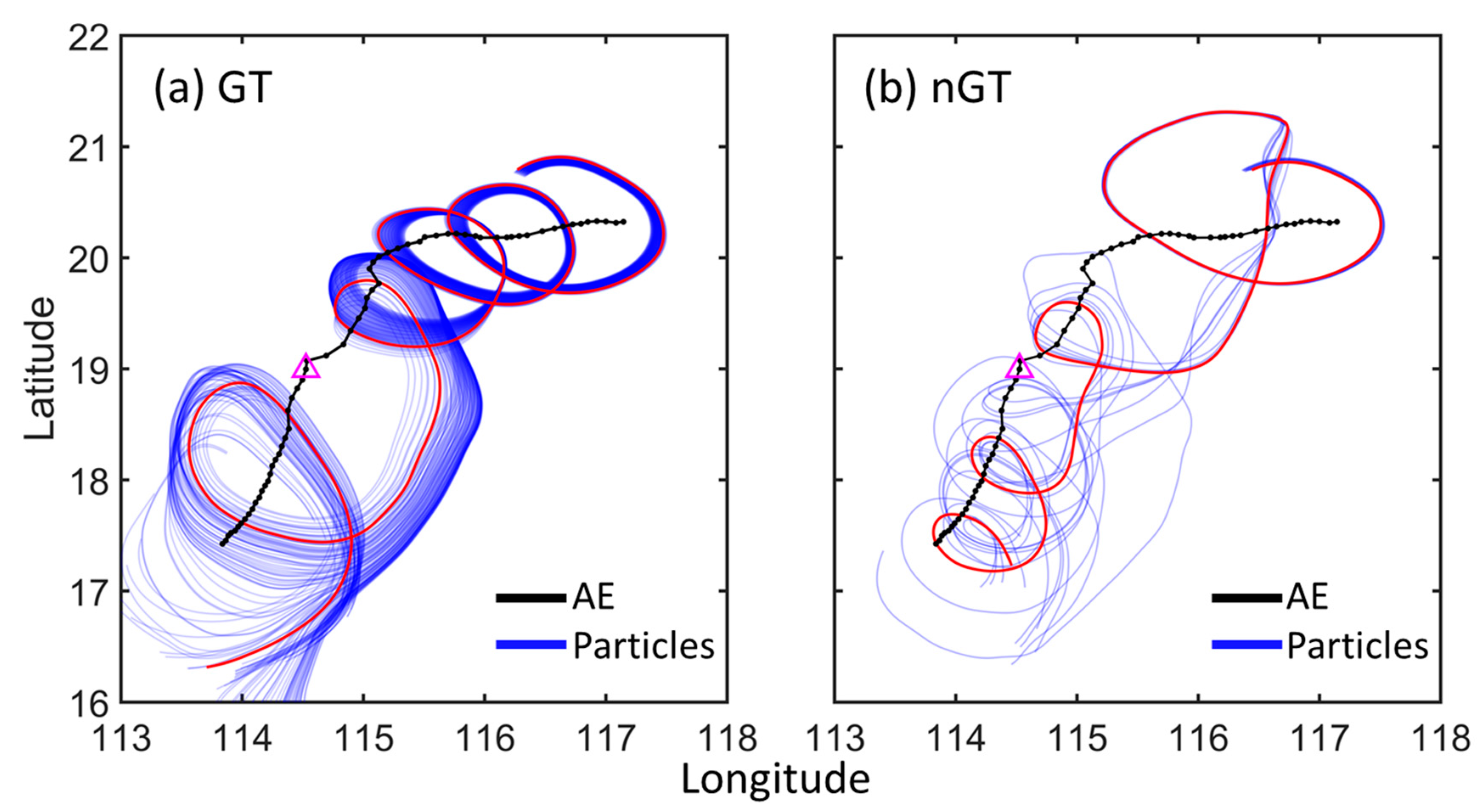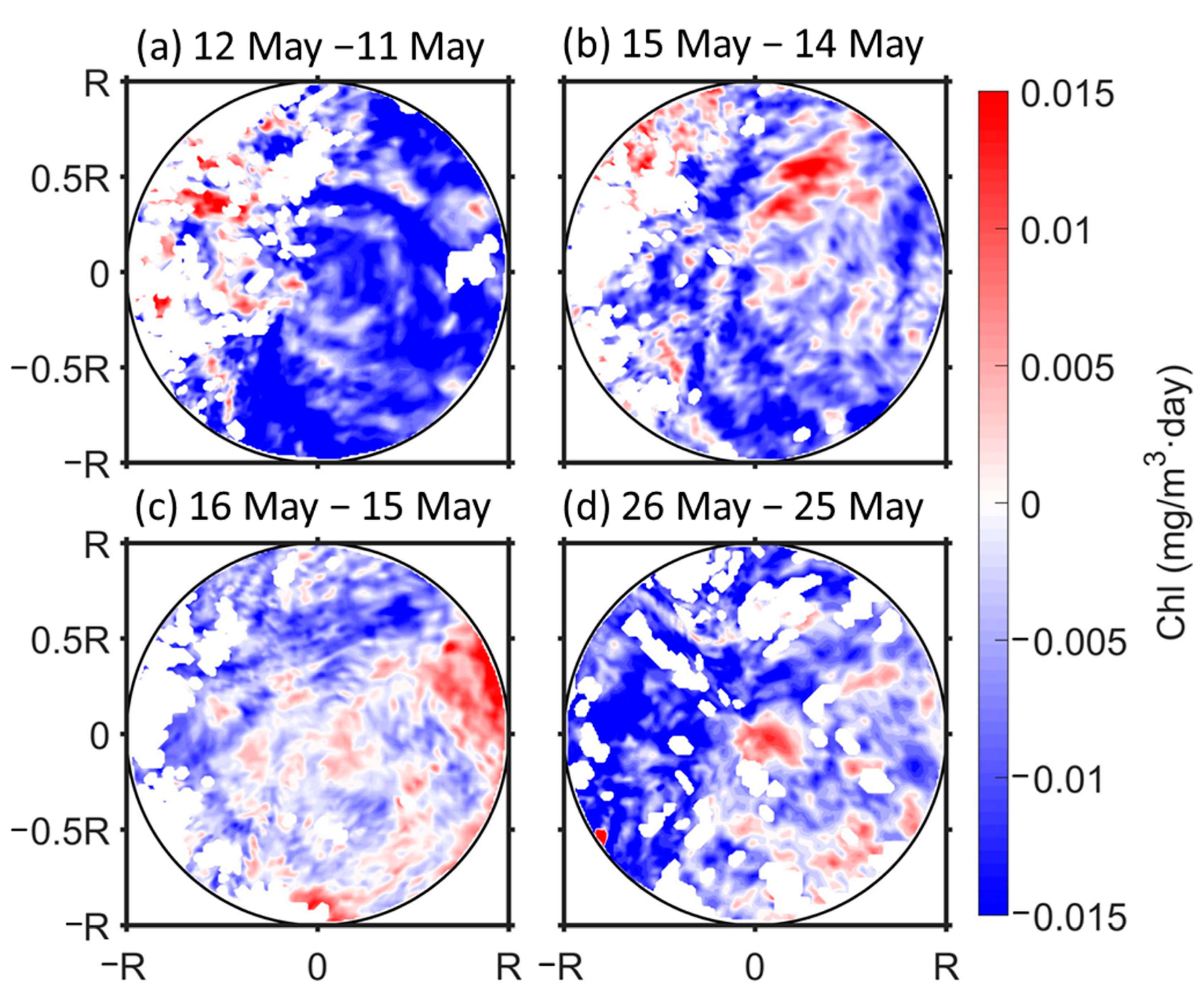Asymmetric Drifter Trajectories in an Anticyclonic Mesoscale Eddy
Abstract
:1. Introduction
2. Data and Methods
3. Results
3.1. Asymmetric Trajectories of Drifters
3.2. Ocean Particle-Tracking Experiments
3.3. Ageostrophic Currents
3.4. Temporal and Spatial Evolution of Chl-a within the Mesoscale Eddy
4. Summary and Conclusions
Author Contributions
Funding
Data Availability Statement
Acknowledgments
Conflicts of Interest
References
- Chen, G.X.; Hou, Y.J.; Chu, X.Q. Mesoscale eddies in the South China Sea: Mean properties, spatiotemporal variability, and impact on thermohaline structure. J. Geophys. Res. Ocean. 2011, 116, C06018. [Google Scholar] [CrossRef]
- Tuo, P.F.; Yu, J.Y.; Hu, J.Y. The Changing Influences of ENSO and the Pacific Meridional Mode on Mesoscale Eddies in the South China Sea. J. Clim. 2019, 32, 685–700. [Google Scholar] [CrossRef] [Green Version]
- Wang, W.Q.; Wang, D.X.; Qi, Y.Q. Large scale characteristics of interannual variability of sea surface temperature in the South China Sea. Acta Oceanol. Sin. 2000, 22, 8216. [Google Scholar]
- Wang, D.; Wang, W.; Shi, P.; Guo, P.; Gan, Z. Establishment and adjustment of monsoon-driven circulation in the South China Sea. Sci. China Earth Sci. 2003, 46, 173–181. [Google Scholar] [CrossRef]
- Wang, C.; Wang, W.; Wang, D.; Wang, Q. Interannual variability of the South China Sea associated with El Niño. J. Geophys. Res. 2006, 111, C03023. [Google Scholar] [CrossRef]
- Wang, G.H.; Su, J.L.; Chu, P.C. Mesoscale eddies in the South China Sea observed with altimeter data. Geophys. Res. Lett. 2003, 30, 2121. [Google Scholar] [CrossRef] [Green Version]
- Chelton, D.B.; Schlax, M.G.; Samelson, R.M.; de Szoeke, R.A. Global observations of large oceanic eddies. Geophys. Res. Lett. 2007, 34, L15606. [Google Scholar] [CrossRef]
- Chelton, D.B.; Gaube, P.; Schlax, M.G.; Early, J.J.; Samelson, R.M. The influence of nonlinear mesoscale eddies on near-surface oceanic chlorophyll. Science 2011, 334, 328–332. [Google Scholar] [CrossRef] [PubMed]
- Chelton, D.B.; Schlax, M.G.; Samelson, R.M. Global observations of nonlinear mesoscale eddies. Prog. Oceanogr. 2011, 91, 167–216. [Google Scholar] [CrossRef]
- Dong, C.; McWilliams, J.C.; Liu, Y.; Chen, D. Global heat and salt transports by eddy movement. Nat. Commun. 2014, 5, 3294. [Google Scholar] [CrossRef] [Green Version]
- Saravanan, R.; Chang, P. Midlatitude mesoscale ocean-atmosphere interaction and its relevance to S2S prediction. In Sub-Seasonal to Seasonal Prediction; Elsevier: Amsterdam, The Netherlands, 2019; pp. 183–200. [Google Scholar]
- Hwang, C.; Chen, S.-A. Circulations and eddies over the South China Sea derived from TOPEX/Poseidon altimetry. J. Geophys. Res. Ocean. 2000, 105, 23943–23965. [Google Scholar] [CrossRef]
- Xiu, P.; Chai, F.; Shi, L.; Xue, H.; Chao, Y. A census of eddy activities in the South China Sea during 1993–2007. J. Geophys. Res. 2010, 115, C03012. [Google Scholar] [CrossRef] [Green Version]
- Hu, J.; Kawamura, H.; Hong, H.; Qi, Y. A review on the currents in the South China Sea: Seasonal circulation, South China Sea warm current and Kuroshio intrusion. J. Oceanogr. 2000, 56, 607–624. [Google Scholar] [CrossRef]
- Qu, T. Upper-Layer Circulation in the South China Sea. J. Phys. Oceanogr. 2000, 30, 1450–1460. [Google Scholar] [CrossRef]
- Qiu, C.; Yang, Z.; Wang, D.; Feng, M.; Su, J. The Enhancement of Submesoscale Ageostrophic Motion on the Mesoscale Eddies in the South China Sea. J. Geophys. Res. Ocean. 2022, 127, e2022JC018736. [Google Scholar] [CrossRef]
- Zhong, Y.; Bracco, A.; Tian, J.; Dong, J.; Zhao, W.; Zhang, Z. Observed and simulated submesoscale vertical pump of an anticyclonic eddy in the South China Sea. Sci. Rep. 2017, 7, srep44011. [Google Scholar] [CrossRef]
- Danioux, E.; Klein, P.; Rivière, P. Propagation of Wind Energy into the Deep Ocean through a Fully Turbulent Mesoscale Eddy Field. J. Phys. Oceanogr. 2008, 38, 2224–2241. [Google Scholar] [CrossRef]
- Eden, C.; Dietze, H. Effects of mesoscale eddy/wind interactions on biological new production and eddy kinetic energy. J. Geophys. Res. Ocean. 2009, 114, C05023. [Google Scholar] [CrossRef] [Green Version]
- Frenger, I.; Gruber, N.; Knutti, R.; Münnich, M. Imprint of Southern Ocean eddies on winds, clouds and rainfall. Nat. Geosci. 2013, 6, 608–612. [Google Scholar] [CrossRef]
- Rupolo, V. Observing turbulence regimes and Lagrangian dispersal properties in the oceans. In Lagrangian Analysis and Prediction of Coastal and Ocean Dynamics, 2nd ed.; Griffa, A., Kirwan, A.D., Eds.; Cambridge University Press: New York, NY, USA, 2007; pp. 231–274. [Google Scholar]
- Xu, C.; Zhai, X.; Shang, X.-D. Work done by atmospheric winds on mesoscale ocean eddies. Geophys. Res. Lett. 2016, 43, 12174–12180. [Google Scholar] [CrossRef] [Green Version]
- Chu, X.Q.; Xue, H.J.; Qi, Y.Q.; Chen, G.X.; Mao, Q.; Wang, D.X.; Chai, F. An exceptional anticyclonic eddy in the South China Sea in 2010. J. Geophys. Res. Ocean. 2014, 119, 881–897. [Google Scholar] [CrossRef]
- Pasquero, C.; Bracco, A.; Provenzale, A.; Weiss, J.B. Particle motion in a sea of eddies. In Lagrangian Analysis and Prediction of Coastal and Ocean Dynamics, 2nd ed.; Griffa, A., Kirwan, A.D., Eds.; Cambridge University Press: New York, NY, USA, 2007; pp. 89–118. [Google Scholar]
- McWilliams, J.C. Fluid dynamics at the margin of rotational control. Environ. Fluid Mech. 2008, 8, 441–449. [Google Scholar] [CrossRef]
- Zhang, Z.; Qiu, B.; Klein, P.; Travis, S. The influence of geostrophic strain on oceanic ageostrophic motion and surface chlorophyll. Nat. Commun. 2019, 10, 2838. [Google Scholar] [CrossRef] [PubMed] [Green Version]
- Sun, Z.; Hu, J.; Chen, Z.; Zhu, J.; Yang, L.; Chen, X.; Wu, X. A strong Kuroshio intrusion into the South China Sea and its accompanying cold-core anticyclonic eddy in winter 2020–2021. Remote Sens. 2021, 13, 2645. [Google Scholar] [CrossRef]
- Sun, Z.; Hu, J.; Lin, H.; Chen, Z.; Zhu, J.; Yang, L.; Hu, Z.; Wu, X. Lagrangian Observation of the Kuroshio Current by Surface Drifters in 2019. J. Mar. Sci. Eng. 2022, 10, 1027. [Google Scholar] [CrossRef]
- Niiler, P.P.; Sybrandy, A.S.; Bi, K.; Poulain, P.M.; Bitterman, D. Measurements of the water-following capability of holey-sock and TRISTAR drifters. Deep. Sea Res. Part I Oceanogr. Res. Pap. 1995, 42, 1951–1964. [Google Scholar] [CrossRef]
- Nencioli, F.; Dong, C.; Dickey, T.; Washburn, L.; McWilliams, J.C. A vector geometry–based eddy detection algorithm and its application to a high-resolution numerical model product and high-frequency radar surface velocities in the Southern California Bight. J. Atmos. Ocean Technol. 2010, 27, 564–579. [Google Scholar] [CrossRef]
- Lin, X.; Dong, C.; Chen, D.; Liu, Y.; Yang, J.; Zou, B.; Guan, Y. Three-dimensional properties of mesoscale eddies in the South China Sea based on eddy-resolving model output. Deep. Sea Res. Part I Oceanogr. Res. Pap. 2015, 99, 46–64. [Google Scholar] [CrossRef]
- Xia, Q.; Shen, H. Automatic detection of oceanic mesoscale eddies in the South China Sea. Chin. J. Oceanol. 2015, 33, 1334–1348. [Google Scholar] [CrossRef]
- Dee, D.P.; Uppala, S.M.; Simmons, A.J.; Berrisford, P.; Poli, P.; Kobayashi, S.; Andrae, U.; Balmaseda, M.; Balsamo, G.; Bauer, P.; et al. The ERA-Interim reanalysis: Configuration and performance of the data assimilation system. Q. J. R. Meteorol. Soc. 2011, 137, 553–597. [Google Scholar] [CrossRef]
- Mears, C.; Lee, T.; Ricciardulli, L.; Wang, X.; Wentz, F. Improving the Accuracy of the Cross-Calibrated Multi-Platform (CCMP) Ocean Vector Winds. Remote Sens. 2022, 14, 4230. [Google Scholar] [CrossRef]
- Chaigneau, A.; Gizolme, A.; Grados, C. Mesoscale eddies off Peru in altimeter records: Identification algorithms and eddy spatio-temporal patterns. Prog. Oceanogr. 2008, 79, 106–119. [Google Scholar] [CrossRef]
- Lumpkin, R.; Özgökmen, T.; Centurioni, L. Advances in the application of surface drifters. Ann. Rev. Mar. Sci. 2017, 9, 59–81. [Google Scholar] [CrossRef] [Green Version]
- Stewart, R.H. Introduction to Physical Oceanography; Department of Oceanography Texas A & M University: College Station, TX, USA, 2008. [Google Scholar]
- Thomson, R.E.; Emery, W.J. Data Analysis Methods in Physical Oceanography; Newnes: Amsterdam, The Netherlands, 2014. [Google Scholar]
- Richardson, P. A census of eddies observed in North Atlantic SOFAR float data. Prog. Oceanogr. 1993, 31, 1–50. [Google Scholar] [CrossRef]
- Martin, A.P.; Richards, K.J.; Law, C.S.; Liddicoat, M. Horizontal dispersion within an anticyclonic mesoscale eddy. Deep Sea Res. Part II Top. Stud. Oceanogr. 2001, 48, 739–755. [Google Scholar] [CrossRef]
- Morales-Márquez, V.; Hernández-Carrasco, I.; Fox-Kemper, B.; Orfila, A. Ageostrophic contribution by the wind and waves induced flow to the lateral stirring in the Mediterranean Sea. J. Geophys. Res. Ocean. 2023, 128, e2022JC019135. [Google Scholar] [CrossRef]
- Maximenko, N.; Lumpkin, R.; Centurioni, L. Ocean surface circulation. Int. Geophys. 2013, 103, 283–304. [Google Scholar]
- Ralph, E.A.; Niiler, P.P. Wind-driven currents in the tropical Pacific. J. Phys. Oceanogr. 1999, 29, 2121–2129. [Google Scholar] [CrossRef]
- Delandmeter, P.; Van Sebille, E. The Parcels v2. 0 Lagrangian framework: New field interpolation schemes. Geosci. Model Dev. 2019, 12, 3571–3584. [Google Scholar] [CrossRef] [Green Version]
- Niiler, P.P.; Maximenko, N.; Panteleev, G.; Yamagata, T.; Olson, D. Near-surface dynamical structure of the Kuroshio Extension. J. Geophys. Res. Ocean. 2003, 108, 1461. [Google Scholar] [CrossRef]
- Rio, M.H.; Mulet, S.; Picot, N. Beyond GOCE for the ocean circulation estimate: Synergetic use of altimetry, gravimetry, and in situ data provides new insight into geostrophic and Ekman currents. Geophys. Res. Lett. 2014, 41, 8918–8925. [Google Scholar] [CrossRef]
- Huang, G.; Zhan, H.; He, Q.; Wei, X.; Li, B. A Lagrangian study of the near-surface intrusion of Pacific water into the South China Sea. Acta Oceanol. Sin. 2021, 40, 15–30. [Google Scholar] [CrossRef]
- Pazan, S.E.; Niiler, P.P. Recovery of near-surface velocity from undrogued drifters. J. Atmos. Ocean Technol. 2001, 18, 476–489. [Google Scholar] [CrossRef]
- Rio, M.H.; Hernandez, F. High-frequency response of wind-driven currents measured by drifting buoys and altimetry over the world ocean. J. Geophys. Res. Ocean. 2003, 108, 1655. [Google Scholar] [CrossRef]
- Lumpkin, R. Global characteristics of coherent vortices from surface drifter trajectories. J. Geophys. Res. Ocean. 2016, 121, 1306–1321. [Google Scholar] [CrossRef] [Green Version]







| Drifter No. | Date of Capture | Date of the End | Trapped Days | Capture Position |
| D510 | 28 April 2021 | 18 May 2021 | 20 | 114.9°E, 17.8°N |
| D512 | 31 March 2021 | 29 April 2021 | 29 | 116.1°E, 19.3°N |
| D514 | 30 March 2021 | 23 May 2021 | 54 | 116.0°E, 20.5°N |
| D515 | 15 April 2021 | 18 May 2021 | 33 | 116.1°E, 19.8°N |
| D517 | 15 April 2021 | 2 May 2021 | 17 | 116.4°E, 19.8°N |
| D615 | 29 March 2021 | 19 May 2021 | 51 | 115.8°E, 20.8°N |
Disclaimer/Publisher’s Note: The statements, opinions and data contained in all publications are solely those of the individual author(s) and contributor(s) and not of MDPI and/or the editor(s). MDPI and/or the editor(s) disclaim responsibility for any injury to people or property resulting from any ideas, methods, instructions or products referred to in the content. |
© 2023 by the authors. Licensee MDPI, Basel, Switzerland. This article is an open access article distributed under the terms and conditions of the Creative Commons Attribution (CC BY) license (https://creativecommons.org/licenses/by/4.0/).
Share and Cite
Tuo, P.; Hu, Z.; Chen, S.; Hu, J.; Yu, P. Asymmetric Drifter Trajectories in an Anticyclonic Mesoscale Eddy. Remote Sens. 2023, 15, 3806. https://doi.org/10.3390/rs15153806
Tuo P, Hu Z, Chen S, Hu J, Yu P. Asymmetric Drifter Trajectories in an Anticyclonic Mesoscale Eddy. Remote Sensing. 2023; 15(15):3806. https://doi.org/10.3390/rs15153806
Chicago/Turabian StyleTuo, Pengfei, Zhiyuan Hu, Shengli Chen, Jianyu Hu, and Peining Yu. 2023. "Asymmetric Drifter Trajectories in an Anticyclonic Mesoscale Eddy" Remote Sensing 15, no. 15: 3806. https://doi.org/10.3390/rs15153806






